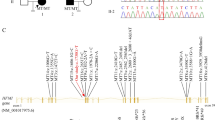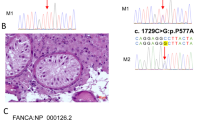Abstract
Purpose
To identify the genetic cause of a cryptorchidism patient carrying a non-canonical splicing variant highlighted by SPCards platform in RXFP2 and to provide a comprehensive overview of RXFP2 variants with cryptorchidism correlation.
Methods
We identified a homozygous non-canonical splicing variant by whole-exome sequencing and Sanger sequencing in a case with cryptorchidism and non-obstructive azoospermia (NOA). As the pathogenicity of this non-canonical splicing variant remained unclear, we initially utilized the SPCards platform to predict its pathogenicity. Subsequently, we employed a minigene splicing assay to further evaluate the influence of the identified splicing variant. Microdissection testicular sperm extraction (micro-TESE) combined with intracytoplasmic sperm injection (ICSI) was performed. PubMed and Human Genome Variant Database (HGMD) were queried to search for RXFP2 variants.
Results
We identified a homozygous non-canonical splicing variant (NM_130806: c.1376-12A > G) in RXFP2, and confirmed this variant caused aberrant splicing of exons 15 and 16 of the RXFP2 gene: 11 bases were added in front of exon 16, leading to an abnormal transcript initiation and a frameshift. Fortunately, the patient successfully obtained his biological offspring through micro-TESE combined with ICSI. Four cryptorchidism-associated variants in RXFP2 from 90 patients with cryptorchidism were identified through a literature search in PubMed and HGMD, with different inheritance patterns.
Conclusion
This is the first cryptorchidism case carrying a novel causative non-canonical splicing RXFP2 variant. The combined approach of micro-TESE and ICSI contributed to an optimal pregnancy outcome. Our literature review demonstrated that RXFP2 variants caused cryptorchidism in a recessive inheritance pattern, rather than a dominant pattern.



Similar content being viewed by others
Data availability
The datasets used and/or analyzed during the current study are available from the corresponding author on reasonable request, without undue reservation.
References
Gurney JK, McGlynn KA, Stanley J, Merriman T, Signal V, Shaw C, et al. Risk factors for cryptorchidism. Nat Rev Urol. 2017;14(9):534–48.
Fantasia J, Aidlen J, Lathrop W, Ellsworth P. Undescended testes: a clinical and surgical review. Urologic Nursing. 2015;35(3):117–26.
Virtanen HE, Toppari J. Epidemiology and pathogenesis of cryptorchidism. Hum Reprod Update. 2008;14(1):49–58.
Dicke AK, Albrethsen J, Hoare BL, Wyrwoll MJ, Busch AS, Fietz D, et al. Bi-allelic variants in INSL3 and RXFP2 cause bilateral cryptorchidism and male infertility. Hum Reprod. 2023;38(7):1412–23.
Ferlin A, Simonato M, Bartoloni L, Rizzo G, Bettella A, Dottorini T, et al. The INSL3-LGR8/GREAT ligand-receptor pair in human cryptorchidism. J Clin Endocrinol Metab. 2003;88(9):4273–9.
Elamo HP, Virtanen HE, Toppari J. Genetics of cryptorchidism and testicular regression. Best Pract Res Clin Endocrinol Metab. 2022;36(1):101619.
Kong RC, Shilling PJ, Lobb DK, Gooley PR, Bathgate RA. Membrane receptors: structure and function of the relaxin family peptide receptors. Mol Cell Endocrinol. 2010;320(1–2):1–15.
Ivell R, Mamsen LS, Andersen CY, Anand-Ivell R. Expression and role of INSL3 in the fetal testis. Front Endocrinol (Lausanne). 2022;13:868313.
Gorlov IP, Kamat A, Bogatcheva NV, Jones E, Lamb DJ, Truong A, et al. mutations of the GREAT gene cause cryptorchidism. Hum Mol Genet. 2002;11(19):2309–18.
Bogatcheva NV, Ferlin A, Feng S, Truong A, Gianesello L, Foresta C, et al. T222P mutation of the insulin-like 3 hormone receptor LGR8 is associated with testicular maldescent and hinders receptor expression on the cell surface membrane. Am J Physiol Endocrinol Metab. 2007;292(1):E138–44.
Ferlin A, Zuccarello D, Zuccarello B, Chirico MR, Zanon GF, Foresta C. Genetic alterations associated with cryptorchidism. JAMA. 2008;300(19):2271–6.
El Houate B, Rouba H, Imken L, Sibai H, Chafik A, Boulouiz R, et al. No association between T222P/LGR8 mutation and cryptorchidism in the Moroccan population. Horm Res. 2008;70(4):236–9.
Nuti F, Marinari E, Erdei E, El-Hamshari M, Echavarria MG, Ars E, et al. The leucine-rich repeat-containing G protein-coupled receptor 8 gene T222P mutation does not cause cryptorchidism. J Clin Endocrinol Metab. 2008;93(3):1072–6.
Ars E, Lo Giacco D, Bassas L, Nuti F, Rajmil O, Ruiz P, et al. Further insights into the role of T222P variant of RXFP2 in non-syndromic cryptorchidism in two Mediterranean populations. Int J Androl. 2011;34(4):333–8.
Tenenbaum-Rakover Y, Admoni O, Elias-Assad G, London S, Noufi-Barhoum M, Ludar H, et al. The evolving role of whole-exome sequencing in the management of disorders of sex development. Endocr Connect. 2021;10(6):620–9.
Ayers K, Kumar R, Robevska G, Bruell S, Bell K, Malik MA, et al. Familial bilateral cryptorchidism is caused by recessive variants in RXFP2. J Med Genet. 2019;56(11):727–33.
Osaka A, Iwahata T, Kobori Y, Shimomura Y, Yoshikawa N, Onota S, et al. Testicular volume in non-obstructive azoospermia with a history of bilateral cryptorchidism may predict successful sperm retrieval by testicular sperm extraction. Reprod Med Biol. 2020;19(4):372–7.
Mieusset R, Fouda PJ, Vaysse P, Guitard J, Moscovici J, Juskiewenski S. Increase in testicular temperature in case of cryptorchidism in boys. Fertil Steril. 1993;59(6):1319–21.
Minhas S, Bettocchi C, Boeri L, Capogrosso P, Carvalho J, Cilesiz NC, et al. European association of urology guidelines on male sexual and reproductive health: 2021 update on male infertility. Eur Urol. 2021;80(5):603–20.
Tang F, Gao Y, Li K, Tang D, Hao Y, Lv M, et al. Novel deleterious splicing variant in HFM1 causes gametogenesis defect and recurrent implantation failure: concerning the risk of chromosomal abnormalities in embryos. J Assist Reprod Genet. 2023;40(7):1689–702.
Tang D, Li K, Geng H, Xu C, Lv M, Gao Y, et al. Identification of deleterious variants in patients with male infertility due to idiopathic non-obstructive azoospermia. Reprod Biol Endocrinol. 2022;20(1):63.
Tang D, Lv M, Gao Y, Cheng H, Li K, Xu C, et al. Novel variants in helicase for meiosis 1 lead to male infertility due to non-obstructive azoospermia. Reprod Biol Endocrinol. 2021;19(1):129.
Ramasamy R, Reifsnyder JE, Husseini J, Eid PA, Bryson C, Schlegel PN. Localization of sperm during microdissection testicular sperm extraction in men with nonobstructive azoospermia. J Urol. 2013;189(2):643–6.
Carrier L, Schlossarek S, Willis MS, Eschenhagen T. The ubiquitin-proteasome system and nonsense-mediated mRNA decay in hypertrophic cardiomyopathy. Cardiovasc Res. 2010;85(2):330–8.
Kato K, Ohno S, Sonoda K, Fukuyama M, Makiyama T, Ozawa T, et al. LMNA missense mutation causes nonsense-mediated mRNA decay and severe dilated cardiomyopathy. Circ Genom Precis Med. 2020;13(5):435–43.
Wright CJ, Smith CWJ, Jiggins CD. Alternative splicing as a source of phenotypic diversity. Nat Rev Genet. 2022;23(11):697–710.
Sanders SJ, Schwartz GB, Farh KK. Clinical impact of splicing in neurodevelopmental disorders. Genome Med. 2020;12(1):36.
Zhang S, Samocha KE, Rivas MA, Karczewski KJ, Daly E, Schmandt B, et al. Base-specific mutational intolerance near splice sites clarifies the role of nonessential splice nucleotides. Genome Res. 2018;28(7):968–74.
Lord J, Gallone G, Short PJ, McRae JF, Ironfield H, Wynn EH, et al. Pathogenicity and selective constraint on variation near splice sites. Genome Res. 2019;29(2):159–70.
Li K, Luo T, Zhu Y, Huang Y, Wang A, Zhang D, et al. Performance evaluation of differential splicing analysis methods and splicing analytics platform construction. Nucleic Acids Res. 2022;50(16):9115–26.
Lee PA, O’Leary LA, Songer NJ, Coughlin MT, Bellinger MF, LaPorte RE. Paternity after unilateral cryptorchidism: a controlled study. Pediatrics. 1996;98(4 Pt 1):676–9.
Jensen MS, Olsen LH, Thulstrup AM, Bonde JP, Olsen J, Henriksen TB. Age at cryptorchidism diagnosis and orchiopexy in Denmark: a population based study of 508,964 boys born from 1995 to 2009. J Urol. 2011;186(4 Suppl):1595–600.
Canavese F, Mussa A, Manenti M, Cortese MG, Ferrero L, Tuli G, et al. Sperm count of young men surgically treated for cryptorchidism in the first and second year of life: fertility is better in children treated at a younger age. Eur J Pediatr Surg. 2009;19(6):388–91.
C. Radmayr. EAU guidelines on paediatric urology. In: the EAU Guidelines 2023. European Association of Urology. 2023. https://uroweb.org/guidelines/paediatric-urology. Accessed 12 Aug 2023.
Alrabeeah K, Wachter A, Phillips S, Cohen B, Al-Hathal N, Zini A. Sperm retrieval outcomes with microdissection testicular sperm extraction (micro-TESE) in men with cryptozoospermia. Andrology. 2015;3(3):462–6.
Bryson CF, Ramasamy R, Sheehan M, Palermo GD, Rosenwaks Z, Schlegel PN. Severe testicular atrophy does not affect the success of microdissection testicular sperm extraction. J Urol. 2014;191(1):175–8.
Chen XL, Wei YA, Ren XH, Zhang X, Li GY, Lu ZW, et al. Predictive factors for successful sperm retrieval by microdissection testicular sperm extraction in men with nonobstructive azoospermia and a history of cryptorchidism. Asian J Androl. 2022;24(5):503–8.
Acknowledgements
We would like to thank all the individuals who participated in and supported this research.
Funding
This study was supported by the National Natural Science Foundation of China (No. 82101681, 82071705, and 82101944) and the China Postdoctoral Science Foundation (2023M730019).
Author information
Authors and Affiliations
Contributions
DT, KL, and ML designed the study. ZD and HY collected the samples and data. ZS and KL performed the data analysis. MG, HY, and ZS were responsible for in vitro experimentations. DT and HG were responsible for surgical operations. LR and HG wrote the paper. All authors have read and approved the final manuscript.
Corresponding authors
Ethics declarations
Competing interests
The author declare no competing interests.
Additional information
Publisher's Note
Springer Nature remains neutral with regard to jurisdictional claims in published maps and institutional affiliations.
Lewen Ruan, Meng Gu, and Hao Geng contributed equally to this work and shared first authorship.
Supplementary Information
Below is the link to the electronic supplementary material.
10815_2024_3070_MOESM3_ESM.pdf
Supplementary file3 (PDF 6 KB) Online Source 3 Results of homozygosity mapping. We have employed Automap (https://automap.iob.ch/) for homology mapping of the patient. The blue vertical lines represent the homozygous regions, while the black lines indicate the boundaries of a homozygous region: chr13-30764037-45465272. The red line indicates the location of the homozygous variant c.1376-12A>G identified in this study.
Rights and permissions
Springer Nature or its licensor (e.g. a society or other partner) holds exclusive rights to this article under a publishing agreement with the author(s) or other rightsholder(s); author self-archiving of the accepted manuscript version of this article is solely governed by the terms of such publishing agreement and applicable law.
About this article
Cite this article
Ruan, L., Gu, M., Geng, H. et al. Achieving an optimal pregnancy outcome through the combined utilization of micro-TESE and ICSI in cryptorchidism associated with a non-canonical splicing variant in RXFP2. J Assist Reprod Genet (2024). https://doi.org/10.1007/s10815-024-03070-4
Received:
Accepted:
Published:
DOI: https://doi.org/10.1007/s10815-024-03070-4




